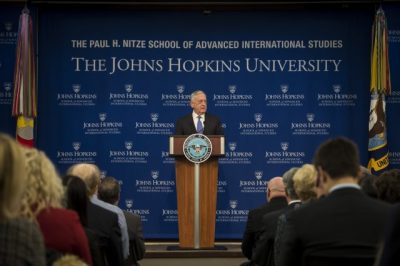The US’ National Defense Strategy’s Focus on Great Power Competition
Epitome of Neo-Realism

Featured image: Defense Secretary James N. Mattis announces the new National Defense Strategy at the Hopkins University, Jan. 19, 2018 (Source: author)
The US’ National Defense Strategy focuses on Great Power competition.
The unclassified summary of the recently released document outlines three prevailing strategic approaches that the Pentagon aims to follow in the coming years, which are to reinforce and expand its alliance system while optimizing military lethality and back-end departmental operations such as logistics and expenditures. The clichéd saying of building a “lean, mean, killing machine” is very apt in this context, but while that’s technically the mission of all militaries, the American one is reconceptualizing its purpose in line with the Neo-Realist paradigm of International Relations and sees its core objective as maintaining a balance of power that can indefinitely sustain its post-Cold War global model.
The US-led world order that America created and ultimately led after 1991 is weakening, and the decentralization trend of multipolarity is chipping away at the centralization status quo of unipolarity. American decision makers believe that their Russian and Chinese rivals who are leading this process have mastered the liberal “rules of the game” and are now adept enough at using international institutions and multilateral trade arrangements to their advantage, thus necessitating the US to reprioritize the Neo-Realist paradigm of power and national interests in response. Washington has always been engaged in Machiavellian machinations of divide and rule, but this time it understands that its chances of success are slim if it’s forced to go head-to-head against the Russian-Chinese Strategic Partnership without any support.
The Libyan War-era policy of “Lead From Behind” has returned to relevancy in response because the US is compelled under these circumstances to rely more on its regional partners who have – or are led to believe that they have – a shared stake in the outcome of the New Cold War. Concurrent with this, however, the Trump Administration seeks to prioritize across-the-board burden-sharing, especially in the operational and financial realms, equalizing the US’ relationship with its allies and forcing them to fairly contribute in all ways if they expect to reap any “rewards” from future joint ventures. In exchange for deepening their full-spectrum military integration with the US, America’s partners can enjoy the economic fruits of the Washington Consensus, though provided that they’re able to successfully preserve it in the face of the Chinese-led Silk World Order and don’t come to believe that Beijing could offer them a better deal.
The transition from unipolarity to multipolarity is clearly being preceded by a period of global chaos made all the more acute by Trump’s “Kraken”-like propensity to shake up the state of international affairs with the intent of creating more strategic opportunities for the US at the expense of its system-challenging Russian and Chinese rivals. Seeing as how the Neo-Realist model is now driving America’s military strategy, it naturally follows that its attendant focus on geopolitics will also be observed by the US as well, thereby explaining why the phrase “Indo-Pacific” is repeated almost a dozen times in the 14-page summarized document. The US obviously wants to use India and a constellation of other allies in this transoceanic space to “contain China” following the same model that it’s been practicing for decades against Russia with NATO, and the end result will likely be that the Pentagon’s “lean, mean, killing machine” engages in more “Lead From Behind” Hybrid Wars against both of their regional interests in the coming years.
Andrew Korybko is an American Moscow-based political analyst specializing in the relationship between the US strategy in Afro-Eurasia, China’s One Belt One Road global vision of New Silk Road connectivity, and Hybrid Warfare.

